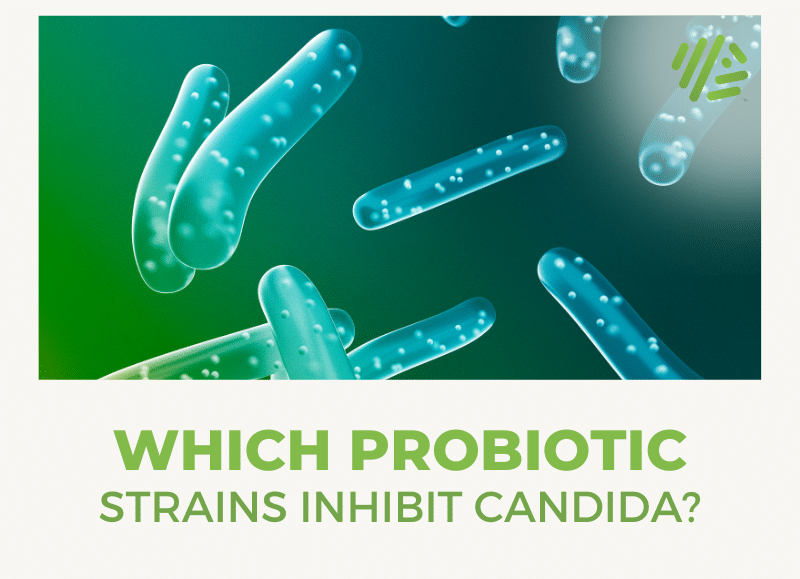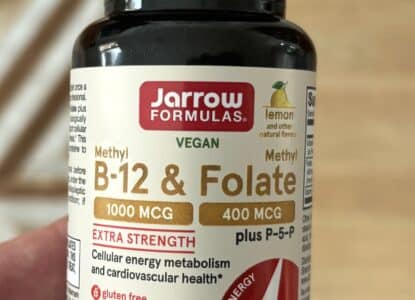Which Probiotic Strains Inhibit Candida?

Contents
Candidiasis is a fungal infection caused by over 20 species of yeasts in the genus Candida. The most common types of Candidiasis are oral thrush, skin infection, and vaginal yeast infection, but Candida overgrowth can also lead to systemic (invasive) Candidiasis.
While most people with a yeast infection have uncomfortable, but generally mild to moderate symptoms, Candidiasis can be fatal in vulnerable individuals. This includes premies (babies born prematurely), very young infants, older adults, and anyone who is immunocompromised, such as someone undergoing chemotherapy or with AIDS.
Antibiotics have no effect on yeasts, and instead actually create the conditions for Candida overgrowth. As such, it’s fortunate that there are many natural remedies, including species of probiotics, for Candida treatment.
See also: S. Boulardii: the probiotic yeast
What is Candida Overgrowth?
Almost all of us carry Candida yeast on our skin, in our gastrointestinal tract, and in our mucous membranes, including in the vagina, mouth, and nasal passages. Even when we’re healthy, Candida is the major fungus in our mouths. 1
Lucky for us, normal immune system function and the other microorganisms making up our microbiomes help to keep Candida in check. The trouble starts when something upsets this balance (creating dysbiosis) and/or suppresses immune system function. Almost 50% of females of reproductive age experience vulvovaginal candidiasis (VVC), typically caused by C. albicans, and Candida can also affect the penis, resulting in inflammation, itching, and urinary and sexual discomfort.2 There is even some limited evidence linking Candida to prostate inflammation.
Candida albicans is, by far, the most common cause of yeast infections in humans, although C. glabrata is increasingly responsible for yeast infections. 3 Together, these two pathogens cause around 65-75% of all systemic Candidiasis infections.4 As the rate of C. glabrata infections rises, it is important to find ways to inhibit the growth of both kinds of Candida.
What Causes Candida overgrowth?
Some common culprits that often precede Candida overgrowth include:
- Antibiotic use
- Steroid use
- Infection and diarrhea or vomiting
- Immunosenescence connected to older age
- Reduced saliva production, typically seen in older adults.5
- Immune suppression due to HIV or AIDS
- Some cancer treatments.
Antibiotic overuse is the leading cause of Candidiasis, meaning that we, as individuals and as a society, would be wise to restrict antibiotic use to when absolutely necessary. Clearly this message isn’t getting through to animal agriculture, which accounts for 80% of all antibiotic use in the U.S. 6
Hormonal disruption can also create the conditions for Candidiasis, with a yeast infection more likely to arise in pregnancy, when taking oral contraceptives, and if you have diabetes.
Tips to Prevent and Manage Candida
Given the numerous potential contributing factors in Candidiasis, there are plenty of things you can do right now to minimize your risk of yeast overgrowth.
Consider switching to a low glycemic protein sources such as beans and lentils. These foods are high in fibre, which not only acts as a prebiotic to feed beneficial bacteria, it also helps keep your blood glucose in check to help thwart yeast infections.
It’s also important to keep on top of hygiene, especially if you use certain medical devices. Catheters, pacemakers, prosthetic joints and limbs, medical instruments and equipment, and even your dentures are some of Candida’s favorite haunts where the yeast likes to form biofilms.7 Ironically, poor hygiene in hospitals and clinics can expose us to virulent Candida when we’re at our most vulnerable.8 Candida may also cause biofilms on sex toys, so be sure to clean these properly (such as in the dishwasher) after each use and avoid sharing them between partners.
And, finally, if you’re plagued by a yeast infection in your skin, take a look at where this occurs. Chances are that your Candidiasis is worst in skin folds. That’s because excess body weight and tight clothing create these ideal sweaty and moist conditions for Candida overgrowth. Being overweight or obese also makes it harder for your body to regulate blood glucose, and poorly managed blood sugar helps to feed Candida growth. Indeed, if you keep getting a yeast infection (recurrent Candidiasis), your doctor might suggest a blood glucose or hemoglobin A 1c test to detect diabetes, pre-diabetes, or gestational diabetes.
Now you have a general idea of some of the main causes of Candidiasis, and some tips to prevent and manage yeast infections, what about treatment, and what about probiotics?
Conventional Treatments for Candida
First line treatment for most cases of Candidiasis is nystatin, an antifungal agent that can be used topically. Fluconazole may also be used as an oral medication, while suppositories or intravaginal antifungals might be used for vaginal yeast overgrowth. Antifungal mouthwashes are available to help with oral thrush.
Severe systemic Candidiasis may be treated using intravenous amphotericin B (an antifungal) or oral fluconazole or other strong antifungal drug a hospital setting, usually for critically ill patients. If recurrent Candidiasis (more than four infections in a year) is an issue, a long-term treatment and control regimen will need to be established. This may necessitate changes in diet, lifestyle, sexual and hygiene habits (Candida can be spread between sexual partners), medications, and other factors, and treatment of any sexual partners.
Unfortunately, as with antibiotic resistance, antifungal resistance is an increasing problem. 9 This means that many researchers are now focusing their attention on alternative ways to treat and prevent Candida, including probiotics, prebiotics, synbiotics, and even biogenics (antifungal substances made by probiotics).
Clinical Trials of Probiotics for Candida Infections
Several studies have found that probiotics can help improve oral thrush, including research by Mendonça et al., Ishikawa et al., and Kraft-Bodi et al.101112
Both the species and the strain of the probiotic are important here, though, as much of the research has found minimal or no evidence of support for oral health from a variety of probiotics shown to support gastrointestinal health.
Researchers have looked at the activity of dozens of Lactobacillus strains, for example, and have found considerable differences in efficacy against Candida. In one study, of 30 lactobacillus strains tested against three strains of C. albicans, L. paracasei 28.4, L. rhamnosus 5.2 and L. fermentum 20.4 isolates showed the greatest antifungal activity, helping to prevent the formation of Candida biofilms.13
Lactobacilli strains produce lactic acid, which has a mild antifungal effect. Some lactobacilli, however, also produce stronger antimicrobial substances that directly inhibit the growth of Candida. These substances include hydrogen peroxide (H2O2), bacteriocins, and other low molecular weight substances.
Lactobacillus strains L. plantarum CMPG5300 and L. rhamnosus GR‐1, also inhibited C. albicans growth by 45-52% in one laboratory study, making these strains comparable to L. rhamnosus GG.14
A recent analysis of seven studies concluded that the use of probiotic supplements for premies was associated with a 57% reduction in the risk of Candida infection, and there was some evidence that probiotics may also reduce the risk of fungal sepsis.15
In one randomized, double-blind, clinical/comparative trial study, individuals with recurrent vaginal candidiasis were treated with oral fluconazole and randomized to either receive a placebo or probiotic treatment (a multistrain lactobacillus formula) for six months. In the six-month period, 35.5% of those receiving placebo had a recurrence of Candidiasis, compared to just 7.2% of the group taking probiotics.16
Some foods that contain probiotics have also been found to have benefit against oral thrush. In one clinical trial, for instance, older adults ate either 50 g/day of a control cheese or a probiotic cheese for 16 weeks (R). The probiotic cheese contained L. lactis, L. helveticus, L. rhamnosus GG, and P. freudenreichii. The probiotic group had a 32% reduction in Candida in their saliva, while the control group actually had an increase in Candida!17
These are just a few studies, of course, with many more available for your reading pleasure. In fact, a quick search of PubMed shows over 16,600 articles that mention probiotics and over 2,000 clinical trials for probiotics. Even a single search for human clinical trials involving L. acidophilus gives over 300 results.
There are now over 50 years’ worth of clinical trials investigating the potential benefits of probiotics, for gastrointestinal health, genitourinary health, oral health, and overall health and wellbeing. And, in recent years, more focus has been turning to the brain benefits of probiotics as researchers begin to understand the gut-brain connection more fully.
For more on the gut brain connection, see Jennifer’s post on probiotics for mental health.
The Best Probiotic Strains for Candida
Most of the trials looking at probiotics for Candida look at how different strains and multistrain supplements affect oral thrush. There are also several trials examining the use of probiotics for vaginal yeast infections. And, a handful of human trials and trials using animal models to assess the effects of various probiotic species on systemic and recurrent Candidiasis. From the information we have currently, the major strains and species of probiotics shown to affect Candida include:
- Lactobacillus rhamnosus GG/LS (R); L. rhamnosus GR-1 (R); L. rhamnosus HS111 (R); L. rhamnosus 5.2 (R)
- L. acidophilus LA02 (R); L. acidophilus ATC 4356 (R); L. acidophilus HS101 (R)
- L. lactis (R)
- L. helveticus (R)
- L. casei GG (R; R)
- L. paracasei 28.4 (R)
- L. plantarum (R); L. plantarum CMPG5300 (R)
- L. reuteri RC-14 (R, R)
- L. fermentum LF10 (R); L. fermentum 20.4 (R)
- Bifidobacterium breve (R)
- B. bifidum (R, R)
- B. animalis (R) and B. animalis subs. lactis (R)
- Saccharomyces cerevisae (R).
This list is by no means exhaustive. Your best bet when choosing probiotics for Candida is to choose a multispecies and multistrain product that contains a dozen or so shelf-stable and gastric acid resistant strains. If the formula includes several of the specific strains from the list above, chances are it will have at least some benefits against yeast infection.
Candida probiotic comparison
| Brand | Product link | Number of Candida-disrupting strains | CFU |
|---|---|---|---|
| Renew Life Ultimate Flora Complete Brobiotic | View on Amazon | 9 strains | 54 billion live Lactobacillus, 36 billion live Bifidobacteria |
| Garden of Life Once Daily Women's Probiotics | View on Amazon | 12 strains | 40 billion live Lactobacillus, 10 billion live Bifidobacteria |
| Webber Naturals Probiotic 30 Billion | View on Amazon | 6 strains | 21 billion live Lactobacillus, 9 billion live Bifidobacteria |
Renew Life Ultimate Flora Complete Probiotic
Hands down, Renew Life Ultimate Flora™ Women’s Complete Probiotic 90 Billion (suitable for people of all genders!) is the best available anti-Candida probiotic currently available.
This impressive 12-strain formula provides 54 billion live Lactobacillus cultures and 36 billion live Bifidobacteria to help restore the normal, healthy balance of these organisms in the genitourinary tract. The water-based enteric coated vegetable capsule help protect the flora from stomach acid, so the organisms get to where they are needed.
Renew Life Ultimate Flora™ Women’s Complete Probiotic includes 8 of the strains (including 2 B. lactis strains) featured in our list above, as well as L. salivarius which has also shown efficacy against Candida, particularly in helping to prevent Candida from sticking to the walls of the genitourinary tract:
- L. acidophilus
- L. plantarum
- L. casei
- L. paracasei
- L. rhamnosus
- B. lactis (2 strains)
- B. bifidum.
Garden of Life Once Daily Women’s Probiotics
Another excellent one-a-day probiotic option, which doesn’t require refrigeration, is Garden of Life Dr. Formulated Once Daily Women’s Probiotics 50 Billion CFU. These shelf-stable capsules can also be opened and mixed with food or a cold beverage. This formula provides 40 billion live Lacto cultures and 10 bn live Bifido cultures including the following 12 strains shown to act against Candida:
- L. acidophilus
- L. plantarum
- L. casei
- L. paracasei
- L. reuteri
- L. salivarius
- L. fermentum
- L. gasseri
- L. rhamnosus
- B. lactis
- B. bifidum
- B. breve.
Garden of Life also offer a shelf-stable probiotic powder version of the formula above in individual packets (ideal for travel or to have on hand at the office), providing 4 grams of prebiotic fiber to support your microflora alongside 50 billion live cultures.
Webber Naturals Probiotic 30 Billion
And, finally, Webber Naturals Probiotic 30 Billion is a shelf-stable 8-strain formula ideal for traveling. This one-a-day formula provides a minimum of 30 billion active cells including the following 6 strains shown to act against Candida:
- L. casei (HA-108) 5.88 billion colony forming units (cfu)
- B. breve (HA-129) 4.5 billion cfu
- L. rhamnosus (HA-111) 4.5 billion cfu
- L. acidophilus (HA-122) 4.2 billion cfu
- L. plantarum (HA-119) 4.2 billion cfu
- L. rhamnosus (HA-500) 2.1 billion cfu.




how can still advise probiotics with magnesium stearate. He would be responsible for the growth of candida albican. Circulate the information, we must boycott the products with magnesium stearate.
The problem with saccharomyces boulardii is that it is a yeast and it kills the beneficial bacteria along with the bad. The best probiotic for candida is bacillus coagulans, which promotes a favorable environment for beneficial bacteria. Eventually you have to build up the good bacteria to keep candida in check.
A good way to take lactobacillus bacteria supplements is with some milk or some lactose powder dissolved in water. Yeast cannot digest lactose, but it is the preferred food for lactobacilli. Beer brewers make something called milk stout. They add lactose to beer to make it sweeter, knowing the yeast cannot ferment it.
Lactobacillus reuteri is very good for fighting candida. The best way to take it is to make yogurt from it, following the directions from Dr. William Davis on the wheat belly blog. If you don’t want milk yogurt, add lactose powder to coconut milk and make it into coconut yogurt. Now brand sells lactose powder online.
ozone therapy and cardio exercise helps ….candida CANT live in oxygen enviroment….keep on Moving ..we r made to move 😉
thank you for the posting. I was wondering which brands and stores provide the candida cure? Which strain rids of Candida glabrata? and whiteness in tongue? greatly appreciated.
I use BioGaia Gastrus to make L. Reuteri yogurt. You can buy it online from Amazon or iHerb. There are various brands of B. Coagulans on Amazon that sell low dose capsules from which you can make yogurt, like Thorne Research and Seeking Health. I find these supplements are too low a dose as is. Making yogurt increases the bacterial count substantially.
To overcome a Candida overgrowth in the digestive tract, of which white tongue is a symptom, you need large doses of probiotic bacteria for an extended period of time. I am too lazy to make yogurt all the time. That is why I use L. Reuteri bulk powder from Custom Probiotics that I buy online. It is 100 billion cfu per gram. I also use bulk powder B. Coagulans from Prescribed For Life on Amazon. I use the one that is 50 billion cfu per gram.
You need to start with a low dose and work your way up. As the yeast die off they release toxins, causing symptoms similar to a hangover or flu. If you kill too much too fast, it can feel like food poisoning.
Please help my life is hell with recurring vaginal thrush and all the sores that come with it .ive tried everything
I have reccuring candidate what probiotic is right for me.
Why isn’t saccharomyces boulardii on this list, that has one the best reported activities against candida albicans?
Hi. Are any of the three probiotics brands you mentioned good for chidren? Age 7. Thank you